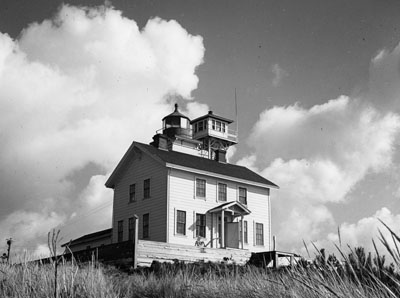Story of Yaquina Bay Lighthouse ghost won't be laid to rest
"The Haunted Light," a fictional story written by Joaquin Miller's sister-in-law, Lischen, in 1899, has taken on a life of its own; in fact, by bringing so much attention and interest to the lighthouse, the story may have saved it from the wrecking ball.
EDITOR'S NOTE: A revised, updated and expanded version of this story was published in 2017 and is recommended in preference to this older one. To read it, click here.
By Finn J.D. John — December 27, 2009

This image of turn-of-the-century beachgoers on the dry sands of the
beach at Newport around 1905 shows the lighthouse above, by then
abandoned and a little eerie looking. (Image: Oregon State University
Archives) [Larger image: 1800 x 1377]
A good ghost story depends for its life on the possibility — faint or imaginary though it may be — that it might be true. So it’s ironic that the Oregon Coast’s most well-known ghost story should be an avowed work of fiction … but is it, really?
Well, yes, of course it is. But there are, actually, some people who aren't fully convinced.
The story started out as a fictional short story published in an 1899 issue of Pacific Monthly magazine. It was penned by the sister-in-law of poet Joaquin Miller — Lischen M. Miller of Eugene.
Joaquin Miller's sister's yarn
The story was titled "The Haunted Light at Newport by the Sea." In it, Miller wove a gripping story of a mysterious young woman left at a Newport hotel by her seafaring father, who plans to pick her up in two weeks. She takes up with a group of tourists from the valley, who are camping nearby.

This very old photograph dates from around 1890, and shows the
Yaquina Bay Lighthouse not long after it was removed from service
.
(Image: University of Oregon Library) [Larger image: 1200 x 620 px]
One day the group of them decides to explore the old Yaquina Bay Lighthouse — a small structure built in an unfortunate spot in 1871 and shut down for good just three years later, to be replaced by the Yaquina Head lighthouse a few miles north. (By the way, "Yaquina" is pronounced "yuh-kwin-uh" — it's a Native American name, not a Spanish one.)
Inside, the adventurers find a secret door leading to a shaft that apparently runs all the way down to the sea. A chill fog moves in and the explorers decide to go, leaving the secret door open behind them.
As she is about to leave, the girl — the author gives her name as Muriel Trevenard — realizes she has left her handkerchief in the lighthouse and goes back to get it. Shortly thereafter, screams are heard; the party races back to the house and finds the secret door closed and locked, and no sign of Muriel save for a pool of “warm blood.”
A fictional story develops a life of its own

The front cover of the first issue of Pacific Monthly,
which
started its run the year before it published "The
Haunted Light."
Lischen Miller was a regular
contributor.
(Image: Google Books) [Link to the Google
e-book; "The
Haunted Light" is on p. 172]
The original of this story is a beautiful piece of 19th-century writing and is well worth the 10 minutes it takes to read. Here's a link to the full text (and a podcasted audio version) in the Offbeat Oregon History "Stories, Legends and Lies of Oregon" series.
(It's also here, in the original 1899 publication, served up by Google Books.)
But the really interesting thing about this story is the life it’s taken on since it was written. Visitors to the lighthouse still ask to see Muriel’s bloodstains on the floor. Condensed versions of the story can be found on paper placemats at Lincoln County restaurants, and reprinted copies of the story are hot items at area “tourist traps.”
Often, when people learn that it’s from an 1899 magazine article, its credibility is enhanced rather than reduced. Monthly fiction magazines are mostly so far in the past that most people don’t remember them, and modern magazines — even literary ones such as The New Yorker — are mostly nonfiction.
It IS fiction ... isn't it?
Indeed, there are lingering doubts as to the truth of the story’s falseness, if you will. This is probably a sort of reverse-psychology wishful thinking — a story this compelling and realistic would be much more powerful if it were possible to believe there's some possibility, however faint, of it being true.
Susan Smitten cites a 1975 article in The Eugene Register-Guard in which Lincoln County Historical Museum curator Pat Stone says a young hitchhiker came through, looking for work.

Yaquina Bay Lighthouse as seen in 1939, with the U.S. Coast Guard tower
rising behind it, in a photo made by Roger Hart. Just a few years after
this image was made, a group of citizens of Lincoln County would rally
to save the picturesque building from demolition.
(Image: University of
Oregon Library) [Larger image: 1200 x 893 px]
Having nowhere to stay and no money to rent a room, he unrolled a sleeping bag at the lighthouse. That night, he said, a ghostly young woman appeared floating outside one of the windows. She told him not to worry, and that he would find work the next day. And so he did.
Whatever the truth, the living and the dead alike owe a debt of gratitude to the citizens of Lincoln County who, in the 1940s, formed the Lincoln County Historical Society specifically to prevent it from being demolished and who — with the help of Ohio industrialist and Oregon native son L.E. Warford — raised the money to do so.
Would that have happened if Miller's story had not made the lighthouse famous and invested it with the romantic, thrilling aura of her mysterious yarn? Maybe not.

This postcard image shows the Yaquina Bay
Lighthouse, site of the legendary and presumably
fictional murder of "Muriel."
Today, restored to its former glory, it’s a state park. It’s also the oldest structure in Newport and the only wooden lighthouse in Oregon.
(Sources: Horner, John B. Oregon Literature. Portland: J.K. Gill, 1902; Smitten, Susan. Ghost Stories of Oregon. Edmonton: Ghost House Books, 2001; www.yaquinalights.org; www.lighthousefriends.com)
-30-












